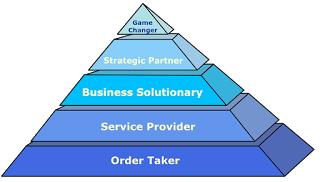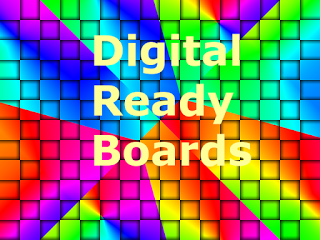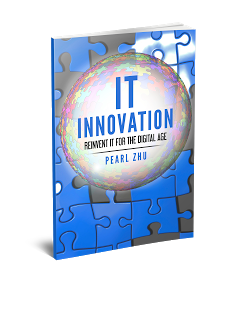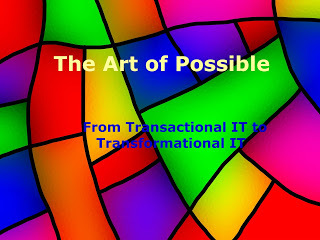Pearl Zhu's Blog, page 1281
November 4, 2016
Building an Evolving Digital Organization
 The very characteristics of the digital age are hyper-connectivity and interdependence. Due to the “VUCA” nature of digitalization, the business complexity is unavoidable, companies that are skilled at managing complexity can gain advantages by pushing the boundaries of a more complicated business mix that provides opportunities to create inter-business value and ultimately building an evolving digital organization.
The very characteristics of the digital age are hyper-connectivity and interdependence. Due to the “VUCA” nature of digitalization, the business complexity is unavoidable, companies that are skilled at managing complexity can gain advantages by pushing the boundaries of a more complicated business mix that provides opportunities to create inter-business value and ultimately building an evolving digital organization.Self-awareness might be the first step to getting involved in a change process: Self-awareness means the true recognition, and total perception of the current state as it is, one’s role in that state and its impact, why and where that state needs to be changed. From change management perspective, many organizations focus so heavily on the “doing,” They lose sight of the “purpose,” the “WHY” part of changes. Once people agree with the “WHY” part of the reasoning, they can develop their own level or means of participating. Because change can not be completely manipulated from top-down, it starts from the mindset. Sometimes people are not part of change because they feel like they don’t need any transformation, and even the ones who recognize the importance or urgency of change, do not understand their own role, impact and most importantly, emotions involved in a change process. Change is a continuum and once you accept that life will be a constant shift going on around us, then you are able to seek ways and means of adjusting your perspective and those around you.
Embracing the “digital holism” for building an ever-evolving digital organization: If the majority of organizations at the industrial age are manipulated by silo thinking and hierarchical style, and then digital means holism and interconnectivity. Building an evolving digital organization is to advocate the concept of “business as a whole is superior to the sum of pieces.” It's important to leverage holistic thinking to understand the variety of business relationship. It is imperative that business leaders are willing to seek out help, break down silos, and harness cross-functional collaboration as they work to generate new ideas or solve problems. It’s important for leaders and managers for learning to think the systemic wholeness, in terms of how to break down silos between subcultures, shared goals. Cross-silo or cross-divisional collaboration is crucial to building dynamic digital capabilities. And organizations arise when the scale of the interrelations, interactions, or interrelational interactions surpasses our brain's capacity to be able to do whatever it does with smaller scales.
 The term ' digital fit' can be interpreted with a degree of variability: At the business level, digital fit is about operational excellence, high-innovativeness, high-effectiveness and agility; At the individual talent level, digital fit starts with digital mindsets and a set of digital skills and capabilities.' Most of the organizations today are process and control driven. Emphasis is on compliance with the result people forget to think freely. ‘Fit' doesn't mean that everyone needs to have the same thought process, the same personalities, the same preferences, or the same experiences. Where you want to look for 'fit' is in relation to the values you want to build or maintain within your team, and the kinds of behaviors that you would expect to see as a result of, or in alignment with, those values. The fitness is also an important predictor of retention, so finding someone with the right fit can be a significant cost saving over time if turnover has been a challenge for you. What is important is that everyone feels committed to the goals of the team, and are comfortable with the behavioral expectations associated with those goals.
The term ' digital fit' can be interpreted with a degree of variability: At the business level, digital fit is about operational excellence, high-innovativeness, high-effectiveness and agility; At the individual talent level, digital fit starts with digital mindsets and a set of digital skills and capabilities.' Most of the organizations today are process and control driven. Emphasis is on compliance with the result people forget to think freely. ‘Fit' doesn't mean that everyone needs to have the same thought process, the same personalities, the same preferences, or the same experiences. Where you want to look for 'fit' is in relation to the values you want to build or maintain within your team, and the kinds of behaviors that you would expect to see as a result of, or in alignment with, those values. The fitness is also an important predictor of retention, so finding someone with the right fit can be a significant cost saving over time if turnover has been a challenge for you. What is important is that everyone feels committed to the goals of the team, and are comfortable with the behavioral expectations associated with those goals.Building an evolving digital organization is about putting people at the center of business. Organizations are running by people to serve people and provide value to the people. When customers are delightful, employees are engaged, and shareholders are satisfied, the business is in the healthy life cycle to run, grow and transform.
Follow us at: @Pearl_Zhu
Published on November 04, 2016 22:56
The New Book “IT Innovation” Introduction Chapter 1 Reinvent IT as an Innovation Hub
 There is no one size fits all formula to run a highly effective and highly innovative IT organization because different IT organizations and the enterprise as whole are at the different stage of the business maturity. Therefore, it’s important for IT leaders to create a comprehensive list of the IT organization’s strengths, weaknesses, goals, and objectives. Digital IT is a paradigm shift in role, responsibility, and attitude. Your goals and objectives will be your drivers. Your strengths and weaknesses will be your constraints. Running IT as an innovation hub means IT can be used as a tool, enabler, catalyzer, and a digital platform to orchestrate change and facilitate idea creation and implementation, meet the ultimate goal of an organization’s short/medium/long-term strategic plans.
There is no one size fits all formula to run a highly effective and highly innovative IT organization because different IT organizations and the enterprise as whole are at the different stage of the business maturity. Therefore, it’s important for IT leaders to create a comprehensive list of the IT organization’s strengths, weaknesses, goals, and objectives. Digital IT is a paradigm shift in role, responsibility, and attitude. Your goals and objectives will be your drivers. Your strengths and weaknesses will be your constraints. Running IT as an innovation hub means IT can be used as a tool, enabler, catalyzer, and a digital platform to orchestrate change and facilitate idea creation and implementation, meet the ultimate goal of an organization’s short/medium/long-term strategic plans. Closing the gaps to run innovative IT: Innovation becomes simply creating value by solving simple and complex problems. There are idea gap, process gap, and innovation execution gap, in innovation management. If you have idea gap, it means the root causes are about talent gap and culture gap. The heterogeneous team with cognitive differences is more innovative than the homogeneous group setting. With building a culture of innovation and risk tolerance, people are more open to trying new things and share thoughts and ideas fearlessly. Even you have ample ideas, it doesn’t guarantee innovation success due to the possible execution gap. Bridging innovation execution gap requires a systematic execution scenario with clear stages, performance thresholds, decision-making parameters combined with the iterative learning process that supports wide-ranging exploration at each stage. Innovation is not serendipity, it takes a systematic approach with robust, but not overly rigid processes to implement it.
Beware of blind sport in IT innovation: At the dawn of the digital era, with information abundance and disruptive forces of technology, IT often gets criticized because it does not deliver value to the business and its focus is not on the business where it should be. It results in a team that has to spend all their time to “keep the lights on,” rather than focusing on developing strategies that advance the business and give them a competitive edge in the marketplace. If IT organizations are going to move up the maturity curve, they have to be aware of a variety of blind spots. They must alleviate themselves of the mundane, daily tasks that weight them down. High performance cannot be achieved unless the IT department improves their act and must engage the business, not the geek in the tech tower. IT must engage the business more to avoid blind spots and bridge the gaps.
 From transactional IT vs. transformational IT: Generally speaking, transactional refers to operational transactions, taking an input at one one and churning it out at the other with the process in between. Transformational means redesigning existing transactions to something new, being innovative and creative and also introducing completely new transactions hopefully with a strategy that serves the organization well. The pace of changes in IT will force more and more CIOs into transformation-oriented roles, creating business value is what is expected from CIOs. A transformation often needs to break down the outdated rules, to focus on innovation. It requires first shifting mindsets, and then building new skills and reinforcing and embedding new practices and reflexes. And a transformational CIO is innovative, influential and intellectual.
From transactional IT vs. transformational IT: Generally speaking, transactional refers to operational transactions, taking an input at one one and churning it out at the other with the process in between. Transformational means redesigning existing transactions to something new, being innovative and creative and also introducing completely new transactions hopefully with a strategy that serves the organization well. The pace of changes in IT will force more and more CIOs into transformation-oriented roles, creating business value is what is expected from CIOs. A transformation often needs to break down the outdated rules, to focus on innovation. It requires first shifting mindsets, and then building new skills and reinforcing and embedding new practices and reflexes. And a transformational CIO is innovative, influential and intellectual.Ideologically, the highly effective and highly dynamic digital organizations, no matter large or small, have a multitude of positive characteristics: the startup’s business culture - innovative and dynamic; the well-established organization’s structure and expertise; the institute’s learning attitude and agility, as the speed of knowledge life cycle is accelerated. TO reinvent IT, it’s not about controlling, but take more resource to do innovation, not just IT innovation, but business innovation and strengthen the business as a whole to make a leap in the digital transformation.Follow us at: @Pearl_Zhu
Published on November 04, 2016 22:52
November 3, 2016
The Weekly Insight of the “Future of CIO” 11/3/ 2016
[image error]
The “Future of CIO” Blog has reached 1.5 million page views with 3200+ blog posting in 59+ different categories of leadership, management, strategy, digitalization, change/talent, etc. The content richness is not for its own sake, but to convey the vision and share the wisdom. Here is the weekly insight about digital leadership, IT Management, and Talent Management.
The Weekly Insight of the “Future of CIO” 11/3/2016The New Book “IT Innovation - Reinvent IT for the Digital Age” Introduction, Slideshare Presentation:The purpose of “IT innovation - Reinvent IT for the Digital Age” is to help business and IT leaders and digital professionals ride above the learning curve, reinvent IT as an innovation hub and game changer; reimagine IT as an innovation outlier; renovate a hybrid IT and digital organization; fine-tune IT as the digital whole brain of the organization; accelerate IT on the fast lane, rebuild IT as the business capability multiplier; empower IT as a digital change agent; and leverage the “alphabetic elements” to run a highly innovative IT organization for the digital age.
A Progressive Board: A progressive board is built based on progressive mindsets. Progress represents change. Progress itself is a change, either by individual or group efforts or induced by environmental and cultural tangible and intangible force. Without change, one cannot even stagnate, she or he will be on a backward journey. Change the game is a mindset, The progressive digital boards can provide the direction as vision, mission, strategy, as well as leadership skills like delegation, decision-making, and monitoring. The BoD role also sets the top leadership tone, and affects most through congruent behavior, continuous endorsement of the change and regular communication to keep the momentum.
Three Traits of Transformational Leader: Fundamentally, leadership is more about future but starts at today. Leadership is about creating a powerful future that is compelling in the present, utilizes the best talents, capabilities, and resources of their people and organization to drive changes and produce meaningful and valuable results. Change is a vital element for the contemporary organization to stay competitive, and transformation is a radical change. Transformation is the momentum from quantitative accumulation to the quantum leap. What are the unique traits of transformational leaders though?.
The Noble Purposes of IT Performance Management: IT organizations are at the cross-road to either ride above the learning curve of the digital transformation or become irrelevant as a support function. IT metrics has to evolve from being a cost center to becoming a revenue generator. It’s dangerous to impose metrics just because the focus on what’s measurable is manageable. The only way to do this is to show a clear link to top executives between IT efficiency and productivity and top-line revenues. Continually accelerating changes in IT consumption and production requires faster responses and better performance metrics. Start with the noble purposes of IT performance management and then select the right set of metrics for measuring the right things and measure them right. IT measures should cover all areas that contribute to value creation including service quality, employee engagement, customer satisfaction and financial outcomes itself?
Develop the Next Practices to Innovate IT Talent Management? Digital workplaces are diverse and dynamic and digital workforces are multi-generational, multicultural, and multi-devicing than ever today. IT skills gap is not fiction, but a reality. CIOs as “Talent Master,” how to innovate talent management and develop the best and next digital practices for bridging gaps between strategy management and talent management, integrate talent management and performance management into a holistic people management solution and build a high-performing and high-mature digital organization. Blogging is not about writing, but about thinking and innovating the new ideas; it’s not just about WHAT to say, but about WHY to say, and HOW to say it. It reflects the color and shade of your thought patterns, and it indicates the peaks and curves of your thinking waves. Unlike pure entertainment, quality and professional content takes time for digesting, contemplation and engaging, and therefore, it takes the time to attract the "hungry minds" and the "deep souls." It’s the journey to amplify diverse voices and deepen digital footprints, and it's the way to harness your innovative spirit.
Follow us at: @Pearl_Zhu
The Weekly Insight of the “Future of CIO” 11/3/2016The New Book “IT Innovation - Reinvent IT for the Digital Age” Introduction, Slideshare Presentation:The purpose of “IT innovation - Reinvent IT for the Digital Age” is to help business and IT leaders and digital professionals ride above the learning curve, reinvent IT as an innovation hub and game changer; reimagine IT as an innovation outlier; renovate a hybrid IT and digital organization; fine-tune IT as the digital whole brain of the organization; accelerate IT on the fast lane, rebuild IT as the business capability multiplier; empower IT as a digital change agent; and leverage the “alphabetic elements” to run a highly innovative IT organization for the digital age.
A Progressive Board: A progressive board is built based on progressive mindsets. Progress represents change. Progress itself is a change, either by individual or group efforts or induced by environmental and cultural tangible and intangible force. Without change, one cannot even stagnate, she or he will be on a backward journey. Change the game is a mindset, The progressive digital boards can provide the direction as vision, mission, strategy, as well as leadership skills like delegation, decision-making, and monitoring. The BoD role also sets the top leadership tone, and affects most through congruent behavior, continuous endorsement of the change and regular communication to keep the momentum.
Three Traits of Transformational Leader: Fundamentally, leadership is more about future but starts at today. Leadership is about creating a powerful future that is compelling in the present, utilizes the best talents, capabilities, and resources of their people and organization to drive changes and produce meaningful and valuable results. Change is a vital element for the contemporary organization to stay competitive, and transformation is a radical change. Transformation is the momentum from quantitative accumulation to the quantum leap. What are the unique traits of transformational leaders though?.
The Noble Purposes of IT Performance Management: IT organizations are at the cross-road to either ride above the learning curve of the digital transformation or become irrelevant as a support function. IT metrics has to evolve from being a cost center to becoming a revenue generator. It’s dangerous to impose metrics just because the focus on what’s measurable is manageable. The only way to do this is to show a clear link to top executives between IT efficiency and productivity and top-line revenues. Continually accelerating changes in IT consumption and production requires faster responses and better performance metrics. Start with the noble purposes of IT performance management and then select the right set of metrics for measuring the right things and measure them right. IT measures should cover all areas that contribute to value creation including service quality, employee engagement, customer satisfaction and financial outcomes itself?

Develop the Next Practices to Innovate IT Talent Management? Digital workplaces are diverse and dynamic and digital workforces are multi-generational, multicultural, and multi-devicing than ever today. IT skills gap is not fiction, but a reality. CIOs as “Talent Master,” how to innovate talent management and develop the best and next digital practices for bridging gaps between strategy management and talent management, integrate talent management and performance management into a holistic people management solution and build a high-performing and high-mature digital organization. Blogging is not about writing, but about thinking and innovating the new ideas; it’s not just about WHAT to say, but about WHY to say, and HOW to say it. It reflects the color and shade of your thought patterns, and it indicates the peaks and curves of your thinking waves. Unlike pure entertainment, quality and professional content takes time for digesting, contemplation and engaging, and therefore, it takes the time to attract the "hungry minds" and the "deep souls." It’s the journey to amplify diverse voices and deepen digital footprints, and it's the way to harness your innovative spirit.
Follow us at: @Pearl_Zhu
Published on November 03, 2016 22:25
"Digitizing Boardroom" Book Tuning: A Progressive Board -Setting the Top Leadership Tone to Drive Digital Transformation
The difference between a progressive board and a compliant board comes from altitude, attitude, and aptitude that drives continuous progress and and high-maturity.
 At today’s “VUCA” digital dynamic, organizations face both unprecedented opportunities to grow and hyper-competition or great risks to survive. Therefore, the corporate board plays a more significant role in overseeing business strategy, setting principles and policies, and making the judgment on and assurance of corporate action within a framework of practical knowledge. The digital fitting BoD is about mental toughness, progressive perspective, and in-depth business understanding in order to set the right digital leadership tone and lead change effortlessly. Leadership is all about future and progression, so how to build a progressive board to catalyze digital transformation?
At today’s “VUCA” digital dynamic, organizations face both unprecedented opportunities to grow and hyper-competition or great risks to survive. Therefore, the corporate board plays a more significant role in overseeing business strategy, setting principles and policies, and making the judgment on and assurance of corporate action within a framework of practical knowledge. The digital fitting BoD is about mental toughness, progressive perspective, and in-depth business understanding in order to set the right digital leadership tone and lead change effortlessly. Leadership is all about future and progression, so how to build a progressive board to catalyze digital transformation?
A progressive board has the progressive mindset: BoD leadership needs to be future oriented. A progressive board is built based on progressive mindsets. The first principle of a progressive Board needs to be open-minded, foresightful, knowledgeable, innovative and committed in order to contribute to strategy oversight when required and effectively at all times. Progress represents change. Progress itself is a change, either by individual or group efforts or induced by environmental and cultural tangible and intangible force. Change the game is a mindset. The progressive digital boards can provide the direction as vision, mission, strategy, as well as leadership skills like delegation, decision-making, and monitoring. The BoD role also sets the top leadership’s tone for progression and affects most through cohesive communication, congruent behavior, and continuous endorsement of the change to keep the momentum.
A progressive board advocates innovation: Innovation is change and advancement. Innovation is what leads to differentiation and progression. There are many ways to differentiate, and therefore, there are many ways to build innovation into a corporate strategy. Boards oversee strategy, and therefore, boards need to pay more attention to innovation and proactively pursue progression. If you want true innovation, find someone who does. It's time to not just think outside of the box on what type of persons should make up your board, but to seek people who truly think-outside-of-the-box, or more precisely, who can shape a new or bigger box and bring outside in viewpoint. There is friction in making change and progress. Indeed, the moment one begins to work towards one's improvement, one attracts a lot of judgment and criticism. People want to hold you back, and that is the test, not to get trapped, and to continue with focus. BoDs as top leadership team need to walk the talk in the progressive journey of leading forward.
 Progressive BoDs are continuous learners: It’s not the acquisition of knowledge that will make the leader, it is the desire to acquire and apply that knowledge, transform into the insight that will make the leader. Progressive boards make sound judgments based in-depth understanding and multidimensional intelligence. Progress is not hanging onto judgments from a way that does not apply. Insight is judging with an openness and understanding that your parameters for judgment are based on the full learning cycle: information-knowledge-insight-wisdom. The progressive BoDs have global breadth for competitive judgments and opportunities; their inherent nature and ability to adapt allows them to do just that, learn, adapt and provide valuable insights that truly no one else can or could see. Leadership in itself is future driven, in pursuit of human progress, a constant learning process that requires the leader to build experience and to share insight. Leaders not only learn themselves but also advocate a culture of learning.
Progressive BoDs are continuous learners: It’s not the acquisition of knowledge that will make the leader, it is the desire to acquire and apply that knowledge, transform into the insight that will make the leader. Progressive boards make sound judgments based in-depth understanding and multidimensional intelligence. Progress is not hanging onto judgments from a way that does not apply. Insight is judging with an openness and understanding that your parameters for judgment are based on the full learning cycle: information-knowledge-insight-wisdom. The progressive BoDs have global breadth for competitive judgments and opportunities; their inherent nature and ability to adapt allows them to do just that, learn, adapt and provide valuable insights that truly no one else can or could see. Leadership in itself is future driven, in pursuit of human progress, a constant learning process that requires the leader to build experience and to share insight. Leaders not only learn themselves but also advocate a culture of learning.
The difference between a progressive board and a compliant board comes from altitude, attitude, and aptitude that drives continuous progress and become better. Progressive and insightful digital BoDs have better chance to figure out the “secret sauce” of directorship to blend the color of the character and make influence via wisdom and cognizance.
Follow us at: @Pearl_Zhu
 At today’s “VUCA” digital dynamic, organizations face both unprecedented opportunities to grow and hyper-competition or great risks to survive. Therefore, the corporate board plays a more significant role in overseeing business strategy, setting principles and policies, and making the judgment on and assurance of corporate action within a framework of practical knowledge. The digital fitting BoD is about mental toughness, progressive perspective, and in-depth business understanding in order to set the right digital leadership tone and lead change effortlessly. Leadership is all about future and progression, so how to build a progressive board to catalyze digital transformation?
At today’s “VUCA” digital dynamic, organizations face both unprecedented opportunities to grow and hyper-competition or great risks to survive. Therefore, the corporate board plays a more significant role in overseeing business strategy, setting principles and policies, and making the judgment on and assurance of corporate action within a framework of practical knowledge. The digital fitting BoD is about mental toughness, progressive perspective, and in-depth business understanding in order to set the right digital leadership tone and lead change effortlessly. Leadership is all about future and progression, so how to build a progressive board to catalyze digital transformation?A progressive board has the progressive mindset: BoD leadership needs to be future oriented. A progressive board is built based on progressive mindsets. The first principle of a progressive Board needs to be open-minded, foresightful, knowledgeable, innovative and committed in order to contribute to strategy oversight when required and effectively at all times. Progress represents change. Progress itself is a change, either by individual or group efforts or induced by environmental and cultural tangible and intangible force. Change the game is a mindset. The progressive digital boards can provide the direction as vision, mission, strategy, as well as leadership skills like delegation, decision-making, and monitoring. The BoD role also sets the top leadership’s tone for progression and affects most through cohesive communication, congruent behavior, and continuous endorsement of the change to keep the momentum.
A progressive board advocates innovation: Innovation is change and advancement. Innovation is what leads to differentiation and progression. There are many ways to differentiate, and therefore, there are many ways to build innovation into a corporate strategy. Boards oversee strategy, and therefore, boards need to pay more attention to innovation and proactively pursue progression. If you want true innovation, find someone who does. It's time to not just think outside of the box on what type of persons should make up your board, but to seek people who truly think-outside-of-the-box, or more precisely, who can shape a new or bigger box and bring outside in viewpoint. There is friction in making change and progress. Indeed, the moment one begins to work towards one's improvement, one attracts a lot of judgment and criticism. People want to hold you back, and that is the test, not to get trapped, and to continue with focus. BoDs as top leadership team need to walk the talk in the progressive journey of leading forward.
 Progressive BoDs are continuous learners: It’s not the acquisition of knowledge that will make the leader, it is the desire to acquire and apply that knowledge, transform into the insight that will make the leader. Progressive boards make sound judgments based in-depth understanding and multidimensional intelligence. Progress is not hanging onto judgments from a way that does not apply. Insight is judging with an openness and understanding that your parameters for judgment are based on the full learning cycle: information-knowledge-insight-wisdom. The progressive BoDs have global breadth for competitive judgments and opportunities; their inherent nature and ability to adapt allows them to do just that, learn, adapt and provide valuable insights that truly no one else can or could see. Leadership in itself is future driven, in pursuit of human progress, a constant learning process that requires the leader to build experience and to share insight. Leaders not only learn themselves but also advocate a culture of learning.
Progressive BoDs are continuous learners: It’s not the acquisition of knowledge that will make the leader, it is the desire to acquire and apply that knowledge, transform into the insight that will make the leader. Progressive boards make sound judgments based in-depth understanding and multidimensional intelligence. Progress is not hanging onto judgments from a way that does not apply. Insight is judging with an openness and understanding that your parameters for judgment are based on the full learning cycle: information-knowledge-insight-wisdom. The progressive BoDs have global breadth for competitive judgments and opportunities; their inherent nature and ability to adapt allows them to do just that, learn, adapt and provide valuable insights that truly no one else can or could see. Leadership in itself is future driven, in pursuit of human progress, a constant learning process that requires the leader to build experience and to share insight. Leaders not only learn themselves but also advocate a culture of learning.The difference between a progressive board and a compliant board comes from altitude, attitude, and aptitude that drives continuous progress and become better. Progressive and insightful digital BoDs have better chance to figure out the “secret sauce” of directorship to blend the color of the character and make influence via wisdom and cognizance.
Follow us at: @Pearl_Zhu
Published on November 03, 2016 22:21
A Progressive Board: Setting the Top Leadership Tone to Drive Digital Transformation
 At today’s “VUCA” digital dynamic, organizations face both unprecedented opportunities to grow and hyper-competition or great risks to survive. Therefore, the corporate board plays a more significant role in overseeing business strategy, setting principles and policies, and making the judgment on and assurance of corporate action within a framework of practical knowledge. The digital fitting BoD is about mental toughness, progressive perspective, and in-depth business understanding in order to set the right digital leadership tone and lead change effortlessly.
At today’s “VUCA” digital dynamic, organizations face both unprecedented opportunities to grow and hyper-competition or great risks to survive. Therefore, the corporate board plays a more significant role in overseeing business strategy, setting principles and policies, and making the judgment on and assurance of corporate action within a framework of practical knowledge. The digital fitting BoD is about mental toughness, progressive perspective, and in-depth business understanding in order to set the right digital leadership tone and lead change effortlessly. A progressive board has the progressive mindset: BoD leadership needs to be future oriented. A progressive board is built based on progressive mindsets. The first principle of a progressive Board needs to be open-minded, foresightful, knowledgeable, innovative and committed in order to contribute to strategy oversight when required and effectively at all times. Progress represents change. Progress itself is a change, either by individual or group efforts or induced by environmental and cultural tangible and intangible force. Change the game is a mindset. The progressive digital boards can provide the direction as vision, mission, strategy, as well as leadership skills like delegation, decision-making, and monitoring. The BoD role also sets the top leadership’s tone for progression and affects most through congruent behavior, continuous endorsement of the change and regular communication to keep the momentum.
A progressive board advocates innovation: Innovation is change and advancement .Innovation is what leads to differentiation and progression. There are many ways to differentiate, and therefore, there are many ways to build innovation into a corporate strategy. Boards oversee strategy, and therefore, boards need to pay more attention to innovation and proactively pursue progression. If you want true innovation, find someone who does. It's time to not just think outside of the box on what type of persons should make up your board, but to seek people who truly think-outside-of-the-box, or more precisely, who can shape a new or bigger box and bring outside in viewpoint. There is friction in making change and progress. Indeed, the moment one begins to work towards one's improvement, one attracts a lot of judgment and criticism. People want to hold you back, and that is the test, not to get trapped, and to continue with focus. BoDs as top leadership team need to walk the talk in the progress journey of leading forward.
 Progressive BoDs are continuous learners: It’s not the acquisition of knowledge that will make the leader, it is the desire to acquire and apply that knowledge, transform into the insight that will make the leader. Progressive boards make sound judgments based in-depth understanding and multidimensional intelligence. Progress is not hanging onto judgments from a way that does not apply. Insight is judging with an openness and understanding that your parameters for judgment are based on the full learning cycle: information-knowledge-insight-wisdom. The progressive BoDs have global breadth for competitive judgments and opportunities; their inherent nature and ability to adapt allows them to do just that, learn, adapt and provide valuable insights that truly no one else can or could see. Leadership in itself is future driven, in pursuit of human progress, a constant learning process that requires the leader to build experience and to share insight. Leaders not only learn themselves but also advocate a culture of learning.
Progressive BoDs are continuous learners: It’s not the acquisition of knowledge that will make the leader, it is the desire to acquire and apply that knowledge, transform into the insight that will make the leader. Progressive boards make sound judgments based in-depth understanding and multidimensional intelligence. Progress is not hanging onto judgments from a way that does not apply. Insight is judging with an openness and understanding that your parameters for judgment are based on the full learning cycle: information-knowledge-insight-wisdom. The progressive BoDs have global breadth for competitive judgments and opportunities; their inherent nature and ability to adapt allows them to do just that, learn, adapt and provide valuable insights that truly no one else can or could see. Leadership in itself is future driven, in pursuit of human progress, a constant learning process that requires the leader to build experience and to share insight. Leaders not only learn themselves but also advocate a culture of learning.The difference between a progressive board and a compliance board comes from altitude, attitude, and aptitude that drives continuous progress and become better. Progressive and insightful digital BoDs have better chance to figure out the “secret sauce” of directorship to blend the color of the character and make influence via wisdom and cognizance.
Follow us at: @Pearl_Zhu
Published on November 03, 2016 22:21
The New Book “IT Innovation - Reinvent IT for the Digital Age” Book Preview
 Nowadays we are living in an information abundant world where technology is pervasive and the masses are looking for their own experiences to introduce new technology into the business. There are both incremental innovation and radical innovation. IT is often the driving force for both. IT plays a significant role in managing information-knowledge-insight cycle and fostering innovation by leveraging disruptive technologies and enriched information flow. But more specifically, how can IT build differentiated capabilities to become an information power center and an innovation hub?
Nowadays we are living in an information abundant world where technology is pervasive and the masses are looking for their own experiences to introduce new technology into the business. There are both incremental innovation and radical innovation. IT is often the driving force for both. IT plays a significant role in managing information-knowledge-insight cycle and fostering innovation by leveraging disruptive technologies and enriched information flow. But more specifically, how can IT build differentiated capabilities to become an information power center and an innovation hub?The purpose of “IT innovation - Reinvent IT for the Digital Age” is to help business and IT leaders and digital professionals ride above the learning curve, reinvent IT as an innovation hub and game changer; reimagine IT as an innovation outlier; renovate a hybrid IT and digital organization; fine-tune IT as the digital whole brain of the organization; accelerate IT on the fast lane, rebuild IT as the business capability multiplier; empower IT as a digital change agent; and leverage the “alphabetic elements” to run a highly innovative IT organization for the digital age.
Chapter 1 Reinvent IT as an innovation game changer: An innovative and value-driven IT organization needs to understand stakeholders’ expectations and propose an innovation solution portfolio that corresponds to both demand and cost drivers with a focus on business priority and improve the overall business effectiveness, agility, and maturity.
Chapter 2 Reimagine IT as an innovational outlier: Visionary CIOs are often outliers who can step out of a conventional thinking box or linear patterns, to envision the future, help their organizations ride above the latest technology trend and leverage information for catching the new growth opportunity and delighting customers.
Chapter 3 Renovate a hybrid IT and digital organization: Running a hybrid IT organization is about taking balance as a management philosophy. In order to make a solid digital transformation, there are many seemly paradoxical, but indeed coherent elements in running a high-effective IT organization today. IT should combine the next practices and the best practices, strike the right balance of traditional hierarchy and flatter structure; keep the lights on,” and “doing more with innovation” management practices.
Chapter 4 Fine-tune IT as the “digital whole brain” of the organization: Because IT is the steward to manage business information, it is like the business’s nervous system to ensure the right information getting to the right people at the right time to make the right decisions. Digital IT needs to be the “Whole Brain” of the business. Be rational as the “left side of the brain,” and be creative as the “right side of the brain.”
Chapter 5 Accelerate IT on the fast lane: IT plays a pivotal role in driving changes and leading the digital transformation, focus on the fastest speed available, because that is where the main threat to competitiveness. To speed up, IT needs to become an innovation engine of the business, as well as a business enabler to catalyze growth and improve organizational agility.
Chapter 6 Rebuild IT as business capability multiplier: A highly capable IT organization is a business capability multiplier. IT is not just the sum of services or processes, but an enabler of business capabilities which can weave all necessary elements of the business into strategic capabilities and unique competencies of the organization.
Chapter 7 Empower IT as digital Change Agent: Change becomes a dynamic business capability in which IT is the key enabler. IT is not only the superglue but also an integrator to weave all important change elements seamlessly and make people change, process change, and technology change sustainable.
Chapter 8 Run a highly innovative digital-ready IT organization: IT is the business, to unleash the digital potential of IT, organizations need to understand that IT is not just technical or scientific, but also artistic and delightful. At the dawn of the Digital Era, IT needs to become a strategic partner of the business, to unleash the full digital potential of the entire organization.
Chapter 9: The alphabetic elements in digital innovation and IT maturity: A Digital-ready IT organization is a threshold competency of the organization, it is an enabler of business digital capability, goes beyond IT-business alignment, and move up to integration and engagement stage. IT can weave all necessary business elements, from A to Z, either hard or soft, to manage innovation and orchestrate a digital symphony.
 Conclusion: The Art of Possible - from Transactional IT to Transformational IT : CIOs as business strategists have to pursue the art of possible - make a shift from mechanical IT to innovative IT, from reactive IT to accelerator IT, and from transactional IT to transformational IT. The art of possible is that it involves new ways of bringing together ideas and resources to create something novel. The art of possible is to deliver the value of information in helping businesses grow, delight customers and unleash its full digital potential.
Conclusion: The Art of Possible - from Transactional IT to Transformational IT : CIOs as business strategists have to pursue the art of possible - make a shift from mechanical IT to innovative IT, from reactive IT to accelerator IT, and from transactional IT to transformational IT. The art of possible is that it involves new ways of bringing together ideas and resources to create something novel. The art of possible is to deliver the value of information in helping businesses grow, delight customers and unleash its full digital potential.Innovative IT can only happen if IT is regarded as a partner and given the role in catalyzing innovation and driving the business. However, the "us vs. them" mentality is often still alive in the management team within the organization. To ensure the business as a whole is superior to the sum of pieces, the business leaders and managers have to overcome silo thinking and empower IT leaders to manage information across functional borders and unleash the full potential of digital businesses. With the changing role of IT in a world that is increasingly more people-centric from a technology perspective, it is imperative that the CIO is a visionary as well. The role of the CIO should be able to envision not only where a company believes it is going, but how it will get there, and how it might be missing out on opportunities because of limitations on understanding. More specifically, the understanding of what technology can help companies achieve. Everyone in the leadership team has a gift and the future business is very complex. Business models and technologies are changing very rapidly. There is no single person who is able to deal with these complexities and speed."Team Leadership" is able to build the future business and IT vision and, more importantly, to react very quickly. Follow us at: @Pearl_Zhu
Published on November 03, 2016 22:17
November 2, 2016
The Monthly Performance Insight: IT Performance Management via Different Lens Nov. 2016
 Corporate Performance Management is a management control from strategy till shop floor. "If you can't measure, you can't manage," legendary management guru Peter Drucker once asserted. He was right Managing performance means understanding results, setting metrics, fixing plans, and making decisions to ensure it happens. It takes multifaceted approaches from multidimensional perspectives. IT Performance Management via Different Lens
Corporate Performance Management is a management control from strategy till shop floor. "If you can't measure, you can't manage," legendary management guru Peter Drucker once asserted. He was right Managing performance means understanding results, setting metrics, fixing plans, and making decisions to ensure it happens. It takes multifaceted approaches from multidimensional perspectives. IT Performance Management via Different LensAssessing IT Performance vs Multidimensional Lenses? IT metrics need to evolve to something that matters to the business audience, at the same time that "business sentiment" needs to get put into something more tangible, such as optimize processes, or improve productivity. The various activities needed to manage performance— STRATEGIC and OPERATIONAL plans, innovation METRICS, day-to-day decisions. Selecting the right key performance indicator is one of the most important steps in measurement because this process includes to answering why you are choosing that, how you will use them and whether you have enough resources to manage data. Always attempt to identify areas in which measurable improvements can be realized, providing demonstrable value is essential, in some instances, these areas have been low-hanging fruit. Your measures should cover all areas that contribute to value creation including service quality, employee engagement, customer satisfaction, innovation benefit, and financial outcomes.
Three Aspects of IT Performance Management Traditional IT organizations were running inside-out operation driven, CIOs and technique managers assess IT performance via the lenses of IT, and mainly about “keeping the business bottom line.” Hence, business partners perceive IT as a cost center, or support desk only, because they don’t have a clear picture with quantitative information about contemporary IT's value proposition, and thus, lack of knowledge on how critical IT contributes to the business’s top-line growth and customer satisfaction. Thus, managing performance and improving IT reputation means understanding results, setting metrics, fixing plans, and making decisions to ensure the strategic goals are on the right track to get implemented, and communicated effectively at the different level of the business. In order to reinvent the tarnished reputation of IT, CIOs need to focusing on managing IT performance effectively via selecting key indicators, measuring both the right things and measuring them in the right way??
Three Perceptions of IT Value Proposition? IT is working hard to transform from a cost center to value center, but some of the challenges facing in IT valuation is that we attempt to apply the same measurement approach to all investments - yet there are unique attributes that differentiate one investment category from another. Further, too often, IT is driving by a look at rear mirror only, not pay enough attention to the front window and create forward-looking view upon how to run IT smoothly, or only focus on ‘tangible’ value, with ignorance of ‘intangible’ one. So what are the best way to present IT value?
Three Aspects in IT Metrics: "If you can't measure, you can't manage," legendary management guru Peter Drucker once asserted. He was right -- just not right enough. The fact of the matter is it's a lot easier to get metrics wrong than right, and the damage caused from getting them wrong usually exceeds the potential benefit from getting them right. This is particularly insightful to measure modern IT performance, it’s no longer a single discipline to measure efficiency anymore, how to measure IT effectiveness and business innovation effort is more crucial than ever.
 IT Performance Management: Two-Level Value Delivery & Balance Scoreboard Traditional IT is still being labeled as cost center, as value hasn’t been conveyed in a structured or quantified way, or it only focuses on measuring internal value (cost efficiency, internal customer satisfaction), but it may not reflect the full set of value IT can bring to accelerate business growth or delight end customers. The issue here is: what is your understanding of value? Is it an economic measure? Is it a competitive measure (when you compare with other IT departments) or other perceptive values? How are you monitoring and quantifying IT Department value in your organization? The tool is secondary if you don't speak the same language with your business partners. Therefore, both strategic and operational metrics are needed in order to paint a full picture of IT performance.
IT Performance Management: Two-Level Value Delivery & Balance Scoreboard Traditional IT is still being labeled as cost center, as value hasn’t been conveyed in a structured or quantified way, or it only focuses on measuring internal value (cost efficiency, internal customer satisfaction), but it may not reflect the full set of value IT can bring to accelerate business growth or delight end customers. The issue here is: what is your understanding of value? Is it an economic measure? Is it a competitive measure (when you compare with other IT departments) or other perceptive values? How are you monitoring and quantifying IT Department value in your organization? The tool is secondary if you don't speak the same language with your business partners. Therefore, both strategic and operational metrics are needed in order to paint a full picture of IT performance.The blog is a dynamic book flowing with your thought; growing through your dedication; sharing your knowledge; conveying your wisdom, and making influence through touching the hearts and connecting the minds across the globe. The “Future of CIO” Blog has reached 1.5 million page views with about #3200 blog posting. Among 59+ different categories of leadership, management, strategy, digitalization, change/talent, etc. Blogging is not about writing, but about thinking and innovating the new ideas; it’s not just about WHAT to say, but about WHY to say, and HOW to say it. It reflects the color and shade of your thought patterns, and it indicates the peaks and curves of your thinking waves. Unlike pure entertainment, quality and professional content takes time for digesting, contemplation and engaging, and therefore, it takes the time to attract the "hungry minds" and the "deep souls." It’s the journey to amplify diverse voices and deepen digital footprints, and it's the way to harness your innovative spirit.
Follow us at: @Pearl_Zhu
Published on November 02, 2016 22:56
"Change Insight" Book Tuning: Achilles’s Heel in Change Management
Change can not be just another thing that needs to be accomplished. It has to be built as an ongoing business capability, and run as a digital continuum.
 Change is inevitable, and the speed of changes is exponentially increasing at today’s “VUCA” digital business new normal. Change also becomes fundamentally difficult in most organizations because it is treated as something distinct from running the business, evolving and increasing results over time. Leaders and employees are stressed enough in getting done what is right in front of them that change is layered upon becomes disruptive. The Change Management failure rate is stubbornly high in the last two decades - more than two-thirds of Change Management effort fail to achieve the expected result statistically. So how to improve leadership effectiveness and business agility via understanding Achilles’s Heel in Change Management?
Change is inevitable, and the speed of changes is exponentially increasing at today’s “VUCA” digital business new normal. Change also becomes fundamentally difficult in most organizations because it is treated as something distinct from running the business, evolving and increasing results over time. Leaders and employees are stressed enough in getting done what is right in front of them that change is layered upon becomes disruptive. The Change Management failure rate is stubbornly high in the last two decades - more than two-thirds of Change Management effort fail to achieve the expected result statistically. So how to improve leadership effectiveness and business agility via understanding Achilles’s Heel in Change Management?
Under-communication: Unclear communication for vision, goals, the need for change, benefits of change and each one's role in the change is a huge mistake. It is important to keep the communications open and creative, not just flat descriptive type, as well as keeping people focused on things they can control. Change needs to have reasons: Remember no one like change, or more precisely “being manually changed,” especially when one can not identify the justification for the change. In today's work environment. It takes a lot of energy to break old habits and outdated thought processes. Too often organizations do a great job of sending out their message that supports the change yet they fail to ever take in any feedback, though. We are human beings interacting with other human beings. A business decision is made via people interaction. People don't fear change; they fear loss. Without information about the change, they make up their own stories. People may not care what you want until they understand WHY. To overcome indifference, clarify the purpose of change, win support for your ideas, reduce the risk for the decision maker. It is challenging to overcome silo mentality, get out of comfort zone, change can not be just another thing that needs to be accomplished. It has to be woven into the collective mentality, process, communication of the organization and action. Successful change and transformations require leaders to over-communicate the transformation vision, frame the right problems and solve them effectively.
Miss the opportunity to build the change momentum: There are two mistakes that people make when making changing strategy. They change it too soon, or they change it too late. Delaying changes can cause lots of unnecessary pains or turn a minor issue into a fatal problem. Changing too slowly will also stifle strategy execution and business growth. Change too fast perhaps has difficulty in sustaining the result - only change behaviors manually, not change mindset behind it. Change occurs at the level of the individual and it is only when the majority of people are on the journey that the real results start to emerge. Major changes in an organization can have unforeseen consequences that could negatively impact the company. Change has to be orchestrated at all levels with the right timing because strategy management and change management need to go hand-in-hand in a timely manner.
 Top-down single directional approach: That means the executives formulate a plan or strategy and drive it through the organization assuming that the organization will accept it. It is commonly noted that most of the 'top-down' driven programs are unsuccessful as they fail to enthuse functional stakeholders. Sometimes Senior executives can be blinded by their previous success and lulled into a false sense of security that success sometimes brings. Such pitfalls are especially dangerous for the large legacy organizations that had a fairly long-running history of success and growth. That past success obfuscated a need for a change in strategic direction at a critical point in time. Employees Buy-in is critical. The most challenging aspect of any change management plan is to gain engagement of the whole workforce. Motivation is right following inspiration. Disregarding motivation will push resistance to very high level and performance on the lowest; therefore, you won't be able to change. And now, social and enterprise collaboration tools do provide effective and interesting multi-channel digital communication platforms to make change management more tangible and measurable.
Top-down single directional approach: That means the executives formulate a plan or strategy and drive it through the organization assuming that the organization will accept it. It is commonly noted that most of the 'top-down' driven programs are unsuccessful as they fail to enthuse functional stakeholders. Sometimes Senior executives can be blinded by their previous success and lulled into a false sense of security that success sometimes brings. Such pitfalls are especially dangerous for the large legacy organizations that had a fairly long-running history of success and growth. That past success obfuscated a need for a change in strategic direction at a critical point in time. Employees Buy-in is critical. The most challenging aspect of any change management plan is to gain engagement of the whole workforce. Motivation is right following inspiration. Disregarding motivation will push resistance to very high level and performance on the lowest; therefore, you won't be able to change. And now, social and enterprise collaboration tools do provide effective and interesting multi-channel digital communication platforms to make change management more tangible and measurable.
Change Management turns to be more complex, be cautious about the Achilles’ Heel in Change Management. Change can not be just another thing that needs to be accomplished. It has to be woven into communication, process, and action of the organization, build as an ongoing business capability, and run as a digital continuum.
Change Insight” Book Ordering Link on Amazon
“Change Insight” Book Ordering Link on B&N
“Change Insight” Book Ordering Link on IBook
“Change Insight” Book Slideshare Presentation
“Change Insight” Book Introduction
“Change Insight” Book Introduction Chapter 1 The Psychology behind Changes
“Change Insight” Book Introduction Chapter 2 The People-Centric Change Management
Change Insight” Book Introduction Chapter 3 Change Leadership
“Change Insight” Book Introduction Chapter 4 Change Principles
“Change Insight” Book Introduction Chapter 5 Change Capability
“Change Insight” Book Introduction Chapter 6 Change Pitfalls
“Change Insight” Book Introduction Chapter 7 Change Assessment and Measurement
“Change Insight” Book Introduction Chapter 8 Building High-Mature Organization with Changeability
“Change Insight” Book Conclusion
“Change Insight” Quote Collection
“Change Insight” Quote Collection II
Follow us at: @Pearl_Zhu
 Change is inevitable, and the speed of changes is exponentially increasing at today’s “VUCA” digital business new normal. Change also becomes fundamentally difficult in most organizations because it is treated as something distinct from running the business, evolving and increasing results over time. Leaders and employees are stressed enough in getting done what is right in front of them that change is layered upon becomes disruptive. The Change Management failure rate is stubbornly high in the last two decades - more than two-thirds of Change Management effort fail to achieve the expected result statistically. So how to improve leadership effectiveness and business agility via understanding Achilles’s Heel in Change Management?
Change is inevitable, and the speed of changes is exponentially increasing at today’s “VUCA” digital business new normal. Change also becomes fundamentally difficult in most organizations because it is treated as something distinct from running the business, evolving and increasing results over time. Leaders and employees are stressed enough in getting done what is right in front of them that change is layered upon becomes disruptive. The Change Management failure rate is stubbornly high in the last two decades - more than two-thirds of Change Management effort fail to achieve the expected result statistically. So how to improve leadership effectiveness and business agility via understanding Achilles’s Heel in Change Management?Under-communication: Unclear communication for vision, goals, the need for change, benefits of change and each one's role in the change is a huge mistake. It is important to keep the communications open and creative, not just flat descriptive type, as well as keeping people focused on things they can control. Change needs to have reasons: Remember no one like change, or more precisely “being manually changed,” especially when one can not identify the justification for the change. In today's work environment. It takes a lot of energy to break old habits and outdated thought processes. Too often organizations do a great job of sending out their message that supports the change yet they fail to ever take in any feedback, though. We are human beings interacting with other human beings. A business decision is made via people interaction. People don't fear change; they fear loss. Without information about the change, they make up their own stories. People may not care what you want until they understand WHY. To overcome indifference, clarify the purpose of change, win support for your ideas, reduce the risk for the decision maker. It is challenging to overcome silo mentality, get out of comfort zone, change can not be just another thing that needs to be accomplished. It has to be woven into the collective mentality, process, communication of the organization and action. Successful change and transformations require leaders to over-communicate the transformation vision, frame the right problems and solve them effectively.
Miss the opportunity to build the change momentum: There are two mistakes that people make when making changing strategy. They change it too soon, or they change it too late. Delaying changes can cause lots of unnecessary pains or turn a minor issue into a fatal problem. Changing too slowly will also stifle strategy execution and business growth. Change too fast perhaps has difficulty in sustaining the result - only change behaviors manually, not change mindset behind it. Change occurs at the level of the individual and it is only when the majority of people are on the journey that the real results start to emerge. Major changes in an organization can have unforeseen consequences that could negatively impact the company. Change has to be orchestrated at all levels with the right timing because strategy management and change management need to go hand-in-hand in a timely manner.
 Top-down single directional approach: That means the executives formulate a plan or strategy and drive it through the organization assuming that the organization will accept it. It is commonly noted that most of the 'top-down' driven programs are unsuccessful as they fail to enthuse functional stakeholders. Sometimes Senior executives can be blinded by their previous success and lulled into a false sense of security that success sometimes brings. Such pitfalls are especially dangerous for the large legacy organizations that had a fairly long-running history of success and growth. That past success obfuscated a need for a change in strategic direction at a critical point in time. Employees Buy-in is critical. The most challenging aspect of any change management plan is to gain engagement of the whole workforce. Motivation is right following inspiration. Disregarding motivation will push resistance to very high level and performance on the lowest; therefore, you won't be able to change. And now, social and enterprise collaboration tools do provide effective and interesting multi-channel digital communication platforms to make change management more tangible and measurable.
Top-down single directional approach: That means the executives formulate a plan or strategy and drive it through the organization assuming that the organization will accept it. It is commonly noted that most of the 'top-down' driven programs are unsuccessful as they fail to enthuse functional stakeholders. Sometimes Senior executives can be blinded by their previous success and lulled into a false sense of security that success sometimes brings. Such pitfalls are especially dangerous for the large legacy organizations that had a fairly long-running history of success and growth. That past success obfuscated a need for a change in strategic direction at a critical point in time. Employees Buy-in is critical. The most challenging aspect of any change management plan is to gain engagement of the whole workforce. Motivation is right following inspiration. Disregarding motivation will push resistance to very high level and performance on the lowest; therefore, you won't be able to change. And now, social and enterprise collaboration tools do provide effective and interesting multi-channel digital communication platforms to make change management more tangible and measurable. Change Management turns to be more complex, be cautious about the Achilles’ Heel in Change Management. Change can not be just another thing that needs to be accomplished. It has to be woven into communication, process, and action of the organization, build as an ongoing business capability, and run as a digital continuum.
Change Insight” Book Ordering Link on Amazon
“Change Insight” Book Ordering Link on B&N
“Change Insight” Book Ordering Link on IBook
“Change Insight” Book Slideshare Presentation
“Change Insight” Book Introduction
“Change Insight” Book Introduction Chapter 1 The Psychology behind Changes
“Change Insight” Book Introduction Chapter 2 The People-Centric Change Management
Change Insight” Book Introduction Chapter 3 Change Leadership
“Change Insight” Book Introduction Chapter 4 Change Principles
“Change Insight” Book Introduction Chapter 5 Change Capability
“Change Insight” Book Introduction Chapter 6 Change Pitfalls
“Change Insight” Book Introduction Chapter 7 Change Assessment and Measurement
“Change Insight” Book Introduction Chapter 8 Building High-Mature Organization with Changeability
“Change Insight” Book Conclusion
“Change Insight” Quote Collection
“Change Insight” Quote Collection II
Follow us at: @Pearl_Zhu
Published on November 02, 2016 22:51
Achilles’s Heel in Change Management
 Change is inevitable, and the speed of changes is increasing at today’s “VUCA” digital business environment. Change also becomes fundamentally difficult in most organizations because it is treated as something distinct from running the business, evolving and increasing results over time. Leaders and employees are stressed enough in getting done what is right in front of them that change is layered upon becomes disruptive. The Change Management failure rate is stubbornly high -more than two-thirds of Change Management effort fail to achieve the expected result statistically. So how to improve leadership effectiveness and business agility via understanding Achilles’s Heel in Change Management?
Change is inevitable, and the speed of changes is increasing at today’s “VUCA” digital business environment. Change also becomes fundamentally difficult in most organizations because it is treated as something distinct from running the business, evolving and increasing results over time. Leaders and employees are stressed enough in getting done what is right in front of them that change is layered upon becomes disruptive. The Change Management failure rate is stubbornly high -more than two-thirds of Change Management effort fail to achieve the expected result statistically. So how to improve leadership effectiveness and business agility via understanding Achilles’s Heel in Change Management?Under-communication: Unclear communication for vision, goals, the need for change, benefits of change and each one's role in the change is a huge mistake. It is important to keep the communications open, as well as keeping people focused on things they can control. Change needs to have reasons: Remember no one like change, or more precisely “being changed,” especially when one can not identify the justification for the change. In today's work environment. It takes a lot of energy to break old habits and outdated thought processes. Too often organizations do a great job of sending out their message that supports the change yet they fail to ever take in any feedback, though. We are human beings interacting with other human beings. A business decision is made via people interaction. People don't fear change; they fear loss. Without information about the change, they make up their own stories. People may not care what you want until they understand WHY. To overcome indifference, clarify the purpose of change, win support for your ideas, reduce the risk for the decision maker. It is challenging to overcome silo mentality, get out of comfort zone, change can not be just another thing that needs to be accomplished. It has to be woven into the collective mentality, process, communication of the organization and action. Successful change and transformations require leaders to over-communicate the transformation vision, frame the right problems and solve them effectively.
Miss the opportunity to build the change momentum: There are two mistakes that people make when changing strategy. They change it too soon, or they change it too late. Delaying changes can cause lots of unnecessary pains or turn a minor issue into a fatal problem. Changing too slowly will also stifle strategy execution and business growth. Change too fast perhaps has difficulty in sustaining the result - only change behaviors manually, not change mindset behind it. Change occurs at the level of the individual and it is only when the majority of people are on the journey that the real results start to emerge. Major changes in an organization can have unforeseen consequences that could negatively impact the company. Change has to be orchestrated at all levels with the right timing because strategy management and change management need to go hand-in-hand in a timely manner.
 Top-down single directional approach: That means the executives formulate a plan or strategy and drive it through the organization assuming that the organization will accept it. It is commonly noted that most of the 'top-down' driven programs are unsuccessful as they fail to enthuse functional stakeholders. Sometimes Senior executives can be blinded by their previous success and lulled into a false sense of security that success sometimes brings. Such pitfalls are especially dangerous for the large legacy organizations that had a fairly long-running history of success and growth. That past success obfuscated a need for a change in strategic direction at a critical point in time. Employees Buy-in is critical. The most challenging aspect of any change management plan is to gain engagement to the whole workforce. Motivation is right following inspiration. Disregarding motivation will push resistance to very high level and performance on the lowest; therefore, you won't be able to change. And now, social and enterprise collaboration tools do provide effective and interesting multichannel digital communication platforms to make change management more tangible and measurable.
Top-down single directional approach: That means the executives formulate a plan or strategy and drive it through the organization assuming that the organization will accept it. It is commonly noted that most of the 'top-down' driven programs are unsuccessful as they fail to enthuse functional stakeholders. Sometimes Senior executives can be blinded by their previous success and lulled into a false sense of security that success sometimes brings. Such pitfalls are especially dangerous for the large legacy organizations that had a fairly long-running history of success and growth. That past success obfuscated a need for a change in strategic direction at a critical point in time. Employees Buy-in is critical. The most challenging aspect of any change management plan is to gain engagement to the whole workforce. Motivation is right following inspiration. Disregarding motivation will push resistance to very high level and performance on the lowest; therefore, you won't be able to change. And now, social and enterprise collaboration tools do provide effective and interesting multichannel digital communication platforms to make change management more tangible and measurable. Change Management turns to be more complex, be cautious about the Achilles’ Heel in change management. Change can not be just another thing that needs to be accomplished. It has to be woven into communication, process, and action of the organization, build as an ongoing business capability, and master change as a business continuum.
Follow us at: @Pearl_Zhu
Published on November 02, 2016 22:51
Embracing the Creative Side of IT to Make Digital Leap
 Many traditional IT organizations are perceived as a support center with “geeky image,” equipped with monolithic hardware, led via command & control management style, suffered from overloading tasks and even experienced the “brain drain.” Nowadays, IT is impacting every business unit and is becoming the driver of business change and digital transformation, besides scientific nature, how to embrace the creative side of IT to make the digital leap?
Many traditional IT organizations are perceived as a support center with “geeky image,” equipped with monolithic hardware, led via command & control management style, suffered from overloading tasks and even experienced the “brain drain.” Nowadays, IT is impacting every business unit and is becoming the driver of business change and digital transformation, besides scientific nature, how to embrace the creative side of IT to make the digital leap?Creative communication: Traditional IT is perhaps like the "left brain" of the business, rationale, machine-like, and a bit isolated, it is easy to get disrupted by digitalization. Most CIOs come up through the ranks on the technical side and think differently than the other executives. Ineffective communication happens when a CIO has one way of thinking and other execs think in a different way. To reinvent the tarnished IT reputation, CIOs have to gain an in-depth understanding of the business, besides IT dialect or finance language, IT leaders need to practice creative communication. As “lost in translation” is the key issue to separate IT from the business, and most CIOs don't know how to sell the value of what their teams deliver. It is worth the effort to take better communication approaches and be both creative and critical in enforcing business and IT collaboration. Visual representations provide a neutral language that is not laden with technology terms and allow an effective conversation to happen between the two parties - in fact dramatically accelerates consensus. Analogies are also a powerful tool for communicating between technical IT professionals and non-technical business units. The partnership is of course built over time, experiment more creative common language to communicate for enforcing understanding and partnership building.
Embracing business creativity and innovating IT products/services: Business creativity,” is to apply the creative thinking for problem-solving and achieving business goals. Forward-looking IT organizations are transforming from a commodity service provider to an innovation hub of the business; from a controller to an enabler; from operation-driven to customer centric. In order to make such a digital shift, IT must be willing to take the constructive criticism from customers and turn the beating, lashing, and criticism into opportunities by demonstrating through the delivery of successful IT projects that not only benefit the business but gives customers a sense of personal satisfaction. Running innovative IT doesn't mean IT will go “wild,” or "rogue,” it means IT should go smarter and flexible; it doesn't mean IT should get rid of all those processes or IT framework hassles. In fact, creativity and process have to go hand in hand. The right level of guidelines and the set of principles are important, not to stifle innovations, or get too “pushy.” To manage innovation in a structural way, you need to frame the creative process and leverage limited resources to keep focus, set time limits, apply varying thinking techniques for managing innovation portfolios in a more productive and sustainable way.
 IT leaders are in the unique position to orchestrate digital transformation symphony: Digital is the age of options, it provides the opportunity to think the new way to do things, so it forces IT leaders to get really creative on how they architect and implement change, to ensuring IT is strategically positioned to be ahead of where the business is moving and accelerating digital transformation. The CIO is at a unique position in business transformation and needs to handle it cautiously but firmly. The art of possible for running digital IT is to keep the business fluid, digital is all about flow: information flow, idea flow, mind flow and knowledge flow. Because if the organization has got that knowledge, it could accomplish a lot with less, make effective decisions, do more with innovation, and it could also use less than that 80% to achieve more than what it has today. IT captures organizational knowledge to continuously improve performance, and harness innovation, ultimately improves the organizational level efficiency, effectiveness, agility, and maturity. The digital transformation definitely needs technology to make it happen as today no business is independent of IT or rather IT has become the business.
IT leaders are in the unique position to orchestrate digital transformation symphony: Digital is the age of options, it provides the opportunity to think the new way to do things, so it forces IT leaders to get really creative on how they architect and implement change, to ensuring IT is strategically positioned to be ahead of where the business is moving and accelerating digital transformation. The CIO is at a unique position in business transformation and needs to handle it cautiously but firmly. The art of possible for running digital IT is to keep the business fluid, digital is all about flow: information flow, idea flow, mind flow and knowledge flow. Because if the organization has got that knowledge, it could accomplish a lot with less, make effective decisions, do more with innovation, and it could also use less than that 80% to achieve more than what it has today. IT captures organizational knowledge to continuously improve performance, and harness innovation, ultimately improves the organizational level efficiency, effectiveness, agility, and maturity. The digital transformation definitely needs technology to make it happen as today no business is independent of IT or rather IT has become the business. Exceptional IT leadership is key to reimagine IT and reinvent IT as an innovation hub to achieve the art of possible; CIOs need to lead the department so that every level of the organization has great working relationships with the IT teams. The priority for CIOs is to genuinely position IT as an integral and inseparable part of the business as the ‘digital whole brain.’ IT needs to embrace both the scientific side and creative side of the business and helps to build a more creative and productive working atmosphere for today’s digital workforce, to driving business changes and making digital leap.
Follow us at: @Pearl_Zhu
Published on November 02, 2016 22:46



